Rest in Baroque Spain: beds
 In the Early Modern period beds were not only used to give rest to the owners, but they were also a symbol of the wealth and prestige of those who possessed them, as evinced by the fact that they were passed in inheritance from father to son and often appeared in inventories of the gifts of women belonging to the high nobility. Depending on the size, materials, decorations, and the quality of the mattress and sheets, we can speculate on what social class the owners belonged to. But the bed was, in a sense, also a religious symbol, as it was the place where men faced illness or even death, becoming at times in small altars on which the deceased rested. Small beds for individual use became popular in the seventeenth century as a result of the rigid orthodoxy of the Church, which formed a society that tried by all means to avoid physical contact, sin and promiscuity.
In the Early Modern period beds were not only used to give rest to the owners, but they were also a symbol of the wealth and prestige of those who possessed them, as evinced by the fact that they were passed in inheritance from father to son and often appeared in inventories of the gifts of women belonging to the high nobility. Depending on the size, materials, decorations, and the quality of the mattress and sheets, we can speculate on what social class the owners belonged to. But the bed was, in a sense, also a religious symbol, as it was the place where men faced illness or even death, becoming at times in small altars on which the deceased rested. Small beds for individual use became popular in the seventeenth century as a result of the rigid orthodoxy of the Church, which formed a society that tried by all means to avoid physical contact, sin and promiscuity.
In Spanish Baroque there are basically three types of beds, depending on their shape. On the one hand, the models of Italian-inspired bed with a canopy, with Solomonic columns supported on plinths, and the bed with four poles or pillars at the corners of medium height, surmounted by spheres or finials (photo, Museo Nacional de Artes DecorativasThis museum contains the material culture of Spanish society, which enables us to interpret the ideas and values of its history. It is located in Madrid’s calle Montalbán. of Madrid) and without a canopy. On the other hand, there was the bed with columns, but without a canopy with but with headboard, usually triangular in shape and decorated with geometric or floral themes or with the heraldic symbol of the family. The columns, whether they were half-height or supported the canopy, had rich sculptural decorations, full of angels, caryatids or flowers. Since the twenties of the seventeenth century beds came from Naples with twisted or winding columns, full of decorations with gold or silver trimming. Even in this case, the wood used was primarily nut, or pine. Most mattresses are gone, but we know they were usually made of wool and were placed on networks composed of wooden planks. The foot of the bed had shaped vases or paws of animals. As for the kit, progressively new fabrics were introduced, such as cotton sheets and covers.
